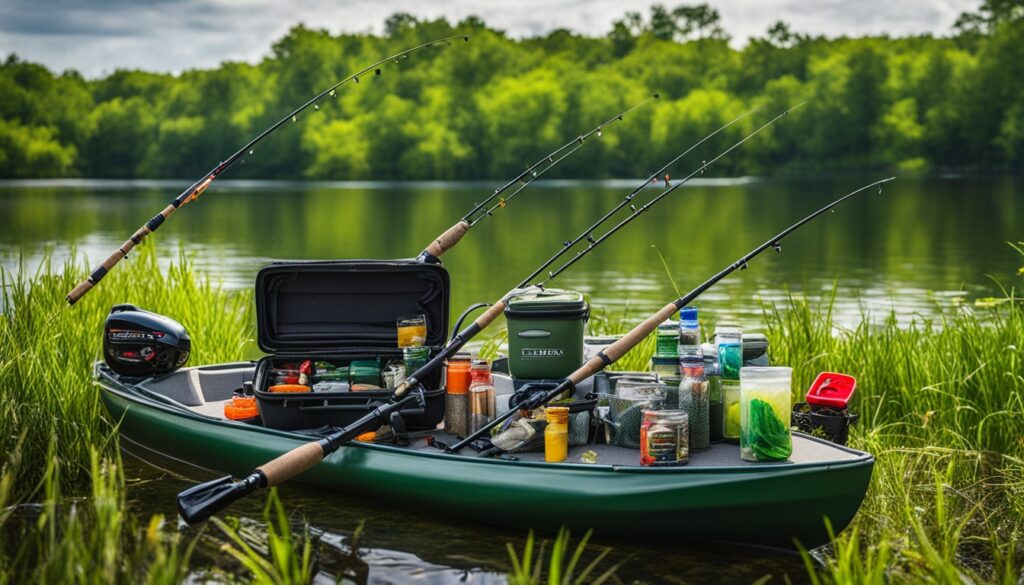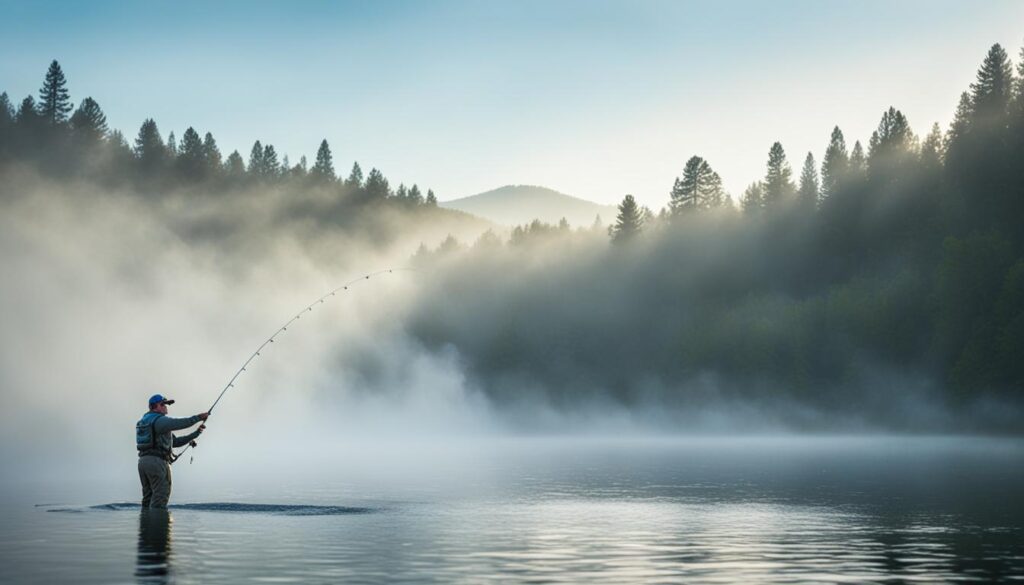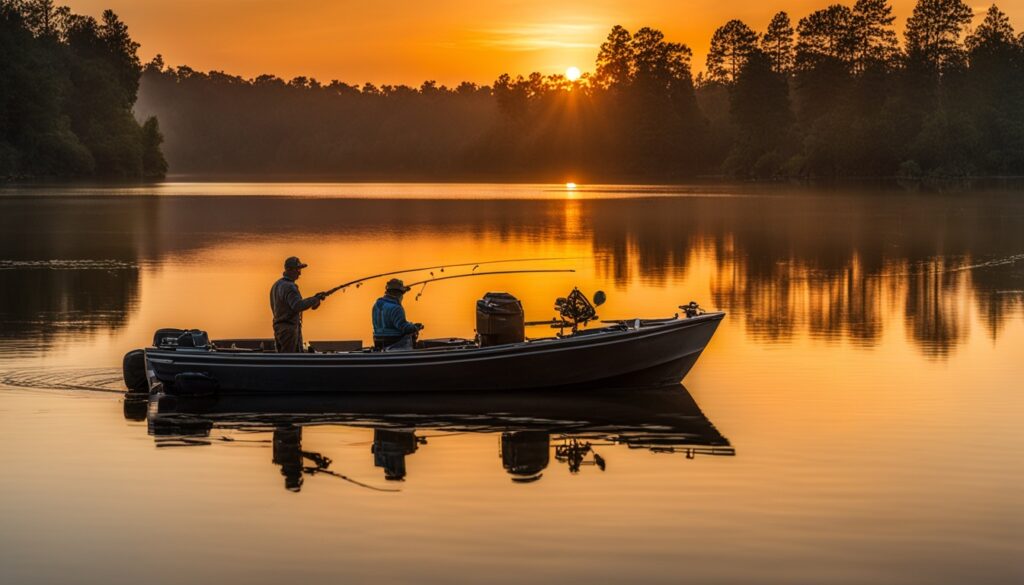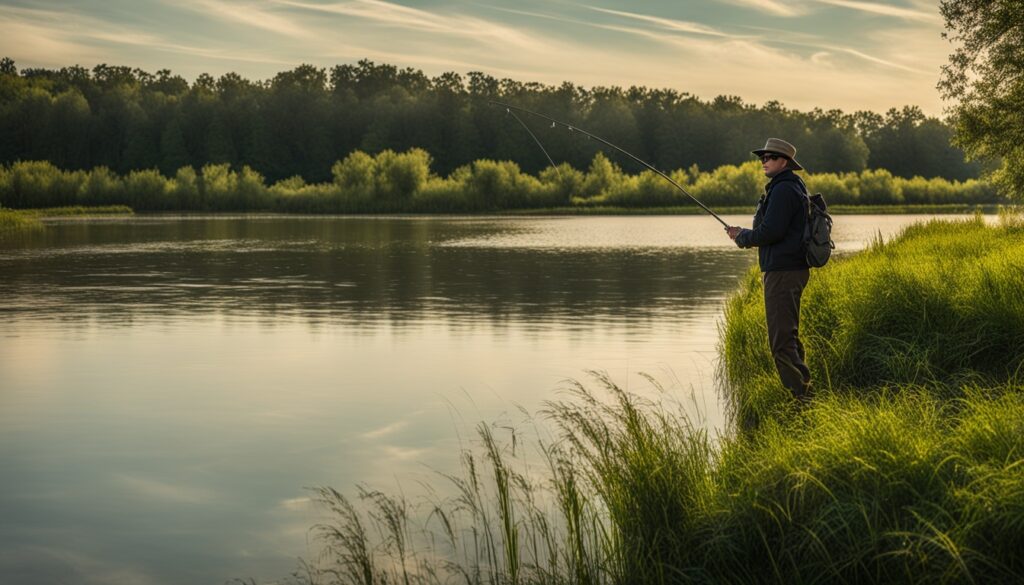When I started fishing, I did not have any mentors. Therefore, I invested my time in trying different lures and techniques. Soon, I caught a big bass. I will present the trials I encountered as a beginner bass fisherman and, hopefully, the benefits that may arise for anyone reading the article.
Largemouth bass, America’s favorite game fish, has a rich history in the country’s angling culture. Smallmouth bass, equally beloved, are close in popularity. To catch bass a lot, you need to know some top tips.
Key Takeaways
- Largemouth bass are the most popular game fish in the United States.
- Smallmouth bass are also highly sought-after by anglers.
- Knowing the best bass fishing tips and techniques is crucial for consistently catching bass.
- Understanding bass behavior and habitat preferences is key to locating and catching them.
- Choosing the right bass fishing gear, from rods and reels to lures and terminal tackle, can make a big difference in your success.
Bass Fishing Tips for Beginners
Learning to fish bass can be intimidating. For beginners, it’s beneficial to start by mastering a few effective bass fishing techniques. Beginner Bass Fishing requires basic bass hooks and basic fishing supplies.
When you acquire the essential Bass tackle arsenal, you must find Bass & learn the proven techniques needed. This game plan can teach you the basics of bass fishing techniques and for bass in the first place with high capture rates.
Understand Bass Behavior and Habitat
Bass are ambush predators with a wide-ranging diet. They eat baitfish such as shad and bluegill, crayfish, and, surprisingly, baby waterfowl. Knowing when and what your local bass are eating is critical. This helps you pick the best lures and techniques.
Find bass near cover and structure during the bass spawn, respawn, and post-spawn. This kind of cover includes docks, laydowns, and timber. Look around currents, points, and ledges. These are spots where bass might be preparing to spawn or eat.
Essential Bass Fishing Gear

Getting the correct bass fishing gear is critical to fishing success. You have to choose between a baitcasting reel and a spinning reel. Baitcasters might be more challenging to learn, but they allow you to cast lures accurately over long distances.
There are many choices for fishing lines, such as braided lines, monofilament, and fluorocarbon. The braided fishing line is often firm and lets you feel the bites better. Monofilament and fluorocarbon also have their benefits, such as bass fishing gear, paying attention to leaders, and terminal tackle, such as hooks and weights, To complete you.
I would like to point out that picking suitable rods and reels is essential for adequately showing your lures and bait to the bass. Aim to buy good bass fishing gear that’s within your budget and fits your own knowledge and approach. Doing this will boost your chances of nabbing more bass.
Mastering Bass Fishing Techniques

Bass Hooks, Sinkers, and Terminal Tackle
It requires chains and hooks, sinkers, jigheads, swivels, and jars. The hook is EWG Worm Hook 3 – 0 or 4h Soft Plastic Worms. Using / 0 matched with 1/0 Octopus Hooks is recommended to make wacky worm rigs. The lighter Round-Bandworm Hook keeps the worm sinking slower and staying out of the water longer if freelining the worms or rigging.
Preparing the worm for Carolina Texas or Drop Shoot Style takes a few sinkers. A 1/4-ounce Wormweight is a staple in the Texas rig. You can use these on the Raleigh Rig on an 8-1/2″ black-plated steel frame.
Common Bass Fishing Lures
Switching to lipless and square bills, depending on specific situations, can cover the best crankbaiting opportunity. Including a plastic worm in your arsenal enhances your bass fishing techniques, offering versatility and effectiveness in various conditions.
This lure, known for its ability to mimic live bait, is essential for experimenting with different approaches to catch bass. The 7-ounce Willow Blade spinster bait, available in blue or white, is easy to thump against cover. Use half an ounce of skirted jig to cut off the debris and accurately flip over overhanging covers with heavy lead.
Topwater lure
On this action-filled day, you should try topwater lures. Walking baits have been widely used for many reasons, including flexibility. Poppers are an excellent choice for the bassist who wants to pull it away. Another common lure for bass fishermen is Buzzbait.
Plastic worms
Although these are no fun, you should try out plastic worms! All Bass will hit Finesseworm. Plastic crawlers can be used in many other ways to imitate bass forage. Incorporating plastic worms into your fishing strategy can significantly enhance your ability to catch fish, especially bass, by mimicking their natural prey more effectively.
Wacky Rig Soft Plastic Baits
Bass lures are often overwhelming, especially for newcomers to a sport. It is challenging to select the most appropriate bait to suit each particular scenario and season, as there is a lot of bait in the world of bait.
If you need a jumping point, use a fun-rigging softplastic sticksbait. The most popular is probably Yamamoto Senko, though similar baits such as Yu-Mi-Zens are also handy.
Best Bass Fishing Lures
If you’re hunting for bass aggressively or biting reactively, you need some tough baits to get it right. Crankbaiters, spinnerbaits, weedless jigs, swimbaits, and floats are commonly found in the bass fish tackle. I’d recommend two crankbait types and a few others.
The lipless sinking crag allows targeting deeper waters with deeper structures, and the shallow diving square bill can cover the whole surface off the shore or in shallow neighborhood lakes.
bass fishing basics

Bass fishing may seem difficult at first for new anglers. But learning some key ideas about bass behavior, habitat preferences, and essential tackle and techniques helps a lot. You can start catching more bass quickly. Understanding how bass feed and where they live is essential start catching fish well. Also, knowing the best bass lures and methods is key to catching them well.
Largemouth and smallmouth bass are top choices for many in the U.S. They’re everywhere and love to fight. Knowing their behavior and where they like to hang out can help you find them more easily. Then, using the right techniques, you’ll start catching bass more often, tackle and tech soon.
Locating Bass Hotspots
Finding bass hotspots is key to boosting your bass fishing success. These spots are where bass hang out, eat, and live. By aiming for these key areas, you’ll have better chances of hooking more bass.
Begin by eyeing the body of water you’re fishing in. Focus on spots like underwater ledges, points, and sudden depth changes – bass love to hide there. Also, watch for places with lots of cover, such as fallen trees or docks. These spots give bass a safe place to hide and hunt.
After spotting the potential bass hotspots, use your gear to check them out. Look for signs like a bunch of baitfish, birds diving to eat, or water changes. These clues can tell you where the bigger bass just might be. Could you mix this with what you know about bass habits? You’ll soon be reeling in more of these exciting fish.
Best Times to Fish For Bass
Almost everyone fishes. A few plan to travel depending on the day’s conditions, but most people are left with the option of fishing. Getting a better understanding of fish activities within specific windows will increase your chances of getting caught. Let’s see some of them briefly and then find out how much time there is for fish.
Low illumination may put your advantage at risk. Sunrise is an excellent opportunity to target bass with only an hour left. They have an essential feeding advantage as they are more hidden. They also work more actively under less sunlight.
FAQ
Largemouth bass lead as America’s favorite game fish. They’re everywhere, making them easily accessible. Smallmouth bass are close behind. However, the best bass fishing tips are needed to catch them often.
What are bass feeding on, and how can you match the hatch with your lure selection?
Bass are ambush predators, big fish that feed on various creatures, such as shad and bluegill. They also eat unique prey, including baby ducks. Knowing what local bass eat and picking lures that match is key.
Should I use a baitcaster or a spinning reel?
Your first step is to decide between a baitcaster and spinning rod tip reel. Baitcasters provide accuracy over long distances but require practice to use well.
What are some easy-to-use lures for beginner bass anglers?
Spinnerbaits are a great start for new bass anglers. Just cast out and reel them in. Adjust your speed for different depths and covers. Use a lighter one in shallow water and a heavier version deeper or in cover.
How can a beginner become a more successful bass angler?
Starting in bass fishing can be daunting. But understanding the basics of bass behavior and where they like to hide, plus a few key tactics, quickly boosts your success.
